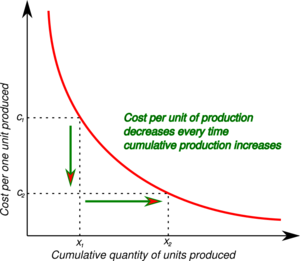Experience curve
| Experience curve |
|---|
| See also |
Experience curve is a graph that shows the effect of improving the organization and functioning of the company. There are many factors that influence the magnitude of this effect, and the most common are:
- increase of the scale of production,
- technical and organizational progress in the production process,
- quality improvement.
Principles of creating the graph
There is a relationship between the scale of production and the size of the unit cost of the product, known as the effect of experience. Graphical image of this effect (created on the basis of cumulative production and unit costs of the sector) is called experience curve.
The graph of the curve is obtained by placing each enterprise in the sector at the point at which unit cost of the product of a company intersects its cumulative production. When you connect the points showing the positions of individual producers you get a graph of the experience curve. The possibility of obtaining a competitive advantage is related to the effect of the experience and depends on the situation within the sector and particularly the rate of growth of demand. When it is too weak, it is difficult to increase production.
Interpretation
The increase in scale of production has a beneficial effect on the unit cost, which generally decreases with the volume of production. It is the interpretation of the law of increasing production. Also, technological advances and organizational development impact in a fundamental way unit costs.
Another area of experience effect is the quality. It concerns: the human factor, the state machinery, and raw material quality. These factors determine the production strategy of the company, which may result in better utilization of productive capacity, as well as lower production costs. In quality analysis experience curve is a graph showing the deficiency of production. Such graph can be considered as the experience curve, the downward trend is expressed in different periods (the effect of experience is a positive dimension). If the chart shows a negative trend of number of defective product, it is called by the term: error (failures) curve.
Knowledge of the experience curve for a given product and its position on this curve allows each company to formulate its own strategy for development of production and unit costs. It also allows you to compare the situation of the cost of all enterprises in the sector and inform investors about the economic barrier to entry to the sector.
See also:
References
- Alberts, W. W. (1989). The experience curve doctrine reconsidered. The Journal of Marketing, 36-49.
- Hall, G., & Howell, S. (1985). The experience curve from the economist's perspective. Strategic Management Journal, 6(3), 197-212.
- Henderson, B. (1974). The Experience Curve Reviewed (p. 211-214). John Wiley & Sons, Inc..
- Henderson, B. D. (1984). The application and misapplication of the experience curve. Journal of Business Strategy, 4(3), 3-9.
